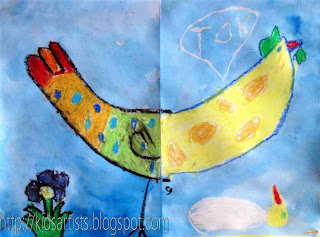You need:
- newspapers torn in strips
wallpaper paste
paper towels
tempera paint
varnish
brushes
yarn
white wall paint
Niki de Saint Phalle
(1930 - 2002) was a French painter and sculptor. She made reliefs in plaster and other materials. Especially her feminine 'Nana's' are famous. These large sculptures of women painted in bright expressive colours are world famous and to be seen in several major cities in the world.
Show some pictures of Niki de Saint Phalle on the digital board. Discuss the salient features: bright colours, black outlinesof the colour patches - including circles, often (thick) women without a clear face. Then show images of the sculptures in Paris (google Nikki de Saint Phalle and Paris). What is different about these images? Those sculptures are the famous female characters, but they do have the typical De Saint Phalle characteristics.
Students are going to create an artwork of paper mache with at least one hole in it and two protruding parts. Provide at least eight layers of newspaper finish with paper towels.
Paint the sculpture after drying with white wall paint and let dry. Paint then in the style of Saint Phalle using bright colors.
Wait until the paint is dry and paint the black lines using a small brush or use a black marker. Paint with varnish. Pull a thread through the hole and hang the work.
Artworks made by students of grade 5
.jpg)
.jpg)
.jpg)
.jpg)
.jpg)
.jpg)
.jpg)
.jpg)
.jpg)
.jpg)